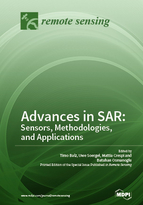Advances in SAR: Sensors, Methodologies, and Applications
A special issue of Remote Sensing (ISSN 2072-4292).
Deadline for manuscript submissions: closed (31 March 2018) | Viewed by 182349
Special Issue Editors
Interests: SAR remote sensing; SAR interferometry; surface motion estimation; SAR in archaeology
Special Issues, Collections and Topics in MDPI journals
Interests: SAR interferometry; object recognition; image analysis
Interests: remote sensing big data analysis; optical and SAR satellite remote sensing; photogrammetry and stereo-SAR; 3D terrain and object modeling; GNSS positioning and monitoring; GNSS seismology; GNSS meteorology
Special Issues, Collections and Topics in MDPI journals
Special Issue Information
Dear Colleagues,
The key importance of radar remote sensing for civil applications has been recognized for decades, and enormous scientific and technical developments have been carried out to further improve SAR sensors and SAR data processing.
In recent years, SAR satellite constellations, consisting of two or more satellites, are becoming the “new normal” in SAR remote sensing. The present availability of SAR sensor constellations, such as Cosmo SkyMed, TerraSAR-X/TanDEM-X, and the new Copernicus sensors Sentinel-1A and 1B, supply a continuous stream of imagery with a unique short revisit cycle of only six days. Together with many more operational and planned SAR satellite systems, such as Geo-Fen 3 or NASA ISRO SAR (NISAR), this unprecedented amount of high-quality SAR data is suitable for a variety of applications, provided proper data processing methodology are applied.
Future concepts, like a geosynchronous SAR or the use of non-traditional orbits for fast revisiting times over areas of interest, are also important concepts for the future development of SAR remote sensing. Therefore, this wide technological availability stimulates methodological advances and innovative concepts, and new applications are opened or already established ones benefit from a sort of second life.
Prof. Dr.-Ing. Timo Balz
Prof. Dr.-Ing. Uwe Soergel
Prof. Dr. Mattia Crespi
Dr. Batuhan Osmanoglu
Guest Editors
Manuscript Submission Information
Manuscripts should be submitted online at www.mdpi.com by registering and logging in to this website. Once you are registered, click here to go to the submission form. Manuscripts can be submitted until the deadline. All submissions that pass pre-check are peer-reviewed. Accepted papers will be published continuously in the journal (as soon as accepted) and will be listed together on the special issue website. Research articles, review articles as well as short communications are invited. For planned papers, a title and short abstract (about 100 words) can be sent to the Editorial Office for announcement on this website.
Submitted manuscripts should not have been published previously, nor be under consideration for publication elsewhere (except conference proceedings papers). All manuscripts are thoroughly refereed through a single-blind peer-review process. A guide for authors and other relevant information for submission of manuscripts is available on the Instructions for Authors page. Remote Sensing is an international peer-reviewed open access semimonthly journal published by MDPI.
Please visit the Instructions for Authors page before submitting a manuscript. The Article Processing Charge (APC) for publication in this open access journal is 2700 CHF (Swiss Francs). Submitted papers should be well formatted and use good English. Authors may use MDPI's English editing service prior to publication or during author revisions.
Keywords
- SAR Sensors
- SAR Interferometry
- DEM Generation from SAR Data
- Surface Motion Estimation from SAR
- SAR Polarimetry
- SAR constellations
- Geosynchronous SAR
- Ground based SAR
- SAR applications









